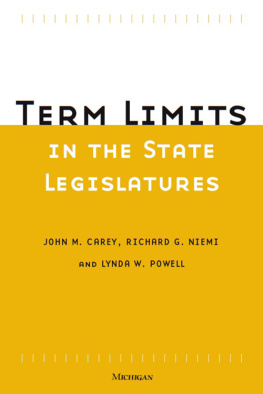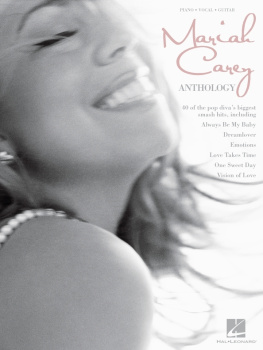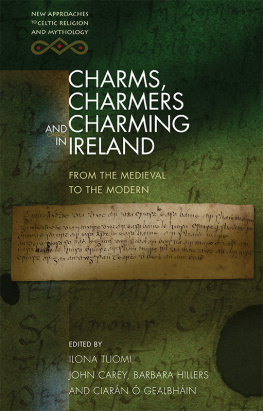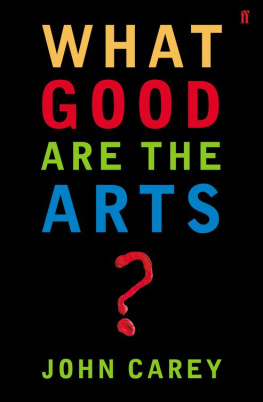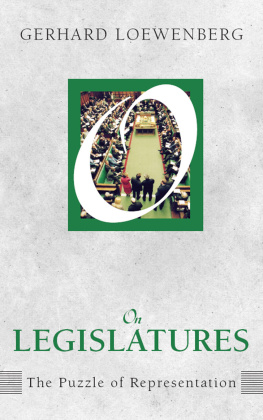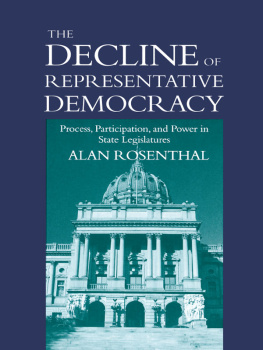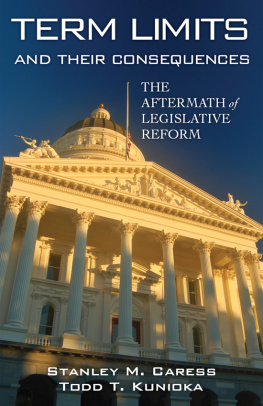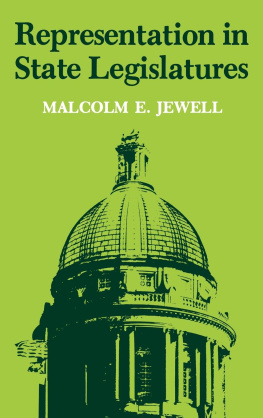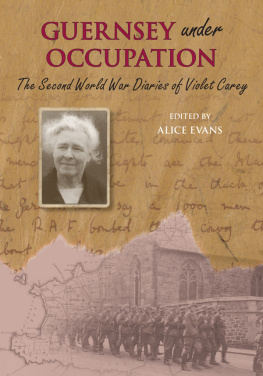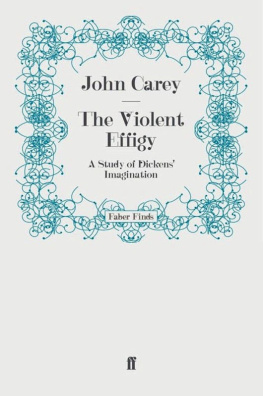Carey John M. - Term Limits in the State Legislatures
Here you can read online Carey John M. - Term Limits in the State Legislatures full text of the book (entire story) in english for free. Download pdf and epub, get meaning, cover and reviews about this ebook. publisher: University of Michigan Press, genre: Politics. Description of the work, (preface) as well as reviews are available. Best literature library LitArk.com created for fans of good reading and offers a wide selection of genres:
Romance novel
Science fiction
Adventure
Detective
Science
History
Home and family
Prose
Art
Politics
Computer
Non-fiction
Religion
Business
Children
Humor
Choose a favorite category and find really read worthwhile books. Enjoy immersion in the world of imagination, feel the emotions of the characters or learn something new for yourself, make an fascinating discovery.
- Book:Term Limits in the State Legislatures
- Author:
- Publisher:University of Michigan Press
- Genre:
- Rating:5 / 5
- Favourites:Add to favourites
- Your mark:
- 100
- 1
- 2
- 3
- 4
- 5
Term Limits in the State Legislatures: summary, description and annotation
We offer to read an annotation, description, summary or preface (depends on what the author of the book "Term Limits in the State Legislatures" wrote himself). If you haven't found the necessary information about the book — write in the comments, we will try to find it.
Term Limits in the State Legislatures — read online for free the complete book (whole text) full work
Below is the text of the book, divided by pages. System saving the place of the last page read, allows you to conveniently read the book "Term Limits in the State Legislatures" online for free, without having to search again every time where you left off. Put a bookmark, and you can go to the page where you finished reading at any time.
Font size:
Interval:
Bookmark:
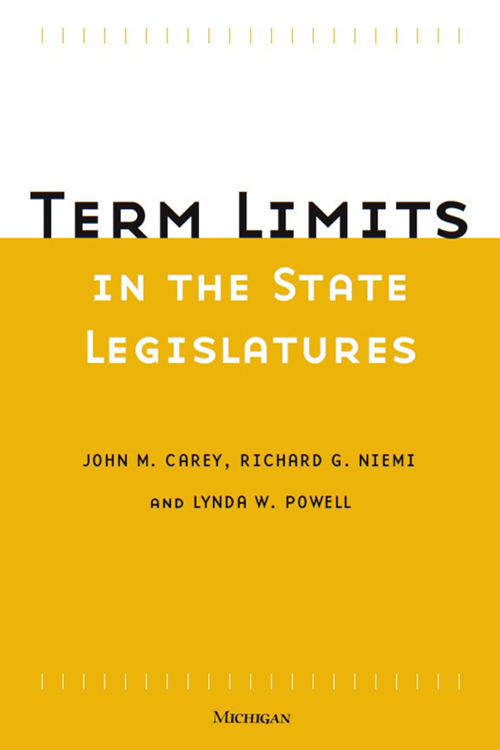
in the State Legislatures
John M. Carey
Richard G. Niemi
and
Lynda W. Powell
THE UNIVERSITY OF MICHIGAN PRESS
Ann Arbor
Copyright by the University of Michigan 2000
All rights reserved
Published in the United States of America by
The University of Michigan Press
Manufactured in the United States of America Printed on acid-free paper
Printed on acid-free paper
2003 2002 2001 2000 4 3 2 1
No part of this publication may be reproduced, stored in a retrieval system, or transmitted in any form or by any means, electronic, mechanical, or otherwise, without the written permission of the publisher.
A CIP catalog record for this book is available from the British Library.
Library of Congress Cataloging-in-Publication Data
Carey, John M.
Term limits in the state legislatures / John M. Carey, Richard G. Niemi, and
Lynda W. Powell.
p. cm.
Includes bibliographical references and index.
ISBN 0-472-09699-0 (cloth : alk. paper) ISBN 0-472-06699-4
(pbk. : alk. paper)
1. LegislatorsTerm of officeUnited StatesStates. 2. Term limits (Public office)United StatesStates. I. Niemi, Richard G. II. Powell, Lynda W.
JK2488 .C37 2000
328.73073dc21 00-023333
ISBN13 978-0-472-09699-2 (cloth : alk. paper)
ISBN13 978-0-472-06699-5 (pbk. : alk. paper)
ISBN13 978-0-472-02410-0 (electronic)
First and foremost, we thank the state legislators who contributed to our study. Thousands of state legislators filled out our mail questionnaire, and twenty-two legislators took time from their busy schedules to answer lengthy questions in person and by telephone. We are very grateful to all these individuals: without their help we could not have written this book.
We also thank the National Science Foundation (Grant SBR-9422375) for making it possible to conduct the survey and to carry out the research. The mail survey was carried out by the Polimetrics Lab at Ohio State University. We are grateful to the lab and its then director, Kathleen Carr. We also appreciate the help of the National Conference of State Legislatures, which provided the names and addresses of current and former legislators as well as a variety of information on legislatures and legislators.
Chris Collet at the University of California, Irvine, did the enormous job of updating the State Legislative Elections file for 1991 through 1994. Earlier data have for some time been available through the Inter-University Consortium for Political and Social Research. Amy Makinen and other graduate students at the University of Rochester helped us to create and keep track of files and to gather supplementary data.
The results in were previewed in an article in Legislative Studies Quarterly (May 1998). However, none of the material from the personal interviews appears in that article. For comments and suggestions, we would like to thank the anonymous reviewers for the Quarterly and the University of Michigan Press, as well as discussants at various meetings at which we have presented parts of our findings.
Legislative term limits, the grassroots electoral reform that swept across much of the United States in the early 1990s, began to kick in during the latter half of the decade. Entire cohorts of lawmakers were removed from office, first in California and Maine; then in Arkansas, Colorado, Michigan, Montana, and Oregon; and subsequently in eleven other states. The onset of limits raises a number of questions about their effects. Among the most pressing: Do term limits produce a new breed of state legislator? Do they alter legislators' behavior and priorities? Do they affect the balance of power among the various actors in the legislative process? Do they affect competition in the broader political system beyond state legislatures? Our summary answers to these questions are as follows: (1) less than one might expect; (2) in some ways yes, in others no; (3) yes, indeed; and (4) yes, under specific conditions. Of course, such summaries inevitably raise more questionsof the who, how, when, and why varietythan they answer. Our purpose in this book is to take the broader questions apart, articulate their logic and their implications, and provide answers to the resulting specific questions about how term limits do (and do not) affect the composition of state legislatures, legislator behavior, various institutional actors' influence on policy, and the broader system of elections.
Debate on how term limits affect state legislatures was heated from the outset, as the reform was endorsed by voters in almost half of the states and, more recently, as legislatures and individual legislators confronted the reality of mandatory termination. The movement's high-water mark was 199294, when, in the course of just two years, seventeen states passed legislation or constitutional amendments limiting the length of time that state legislators could serve, and most of these states imposed limits on their congressional representatives as well. The first major setback came in 1995, when the Supreme Court declared limits on members of Congress to be unconstitutional.because most term-limit laws exempted service prior to the date when the legislation or amendment passed. Until 1996, therefore, no one was actually prohibited from reelection.
At the decade's end, interest in term limits, if not the reform movement itself, rebounded. California's state legislative term limits were upheld by the U.S. Circuit Court of Appeals, and the Supreme Court refused to hear an appeal.
Despite sustained controversy over limits in the press, the courts, Congress and the state legislatures, and reform groups since the first ballot initiatives almost a decade ago, political scientists have only recently begun to weigh in with empirical studies that directly address the effects of term limits in the states. Most analyses of limits were, of necessity until 1996, based on extrapolations from preterm limit electoral data or from data from quite different electoral contexts. Immediately after 1996, the first studies of elections and legislative performance in the term-limits era naturally focused only on California and Maine, the first two states in which incumbents were legally proscribed from office (see, e.g., Daniel and Lott 1997; Chi 1997). This book is the first study to assess the effects of term limits on state legislatures using survey data and election results from all fifty states as well as extensive interview data with legislators in four states. We present data from a 1995 nationwide survey of more than 3,000 current and former legislators. Given that by then nearly half of the states had adopted term limits, legislators and potential legislative candidates had begun anticipating limits' effects and adapting behavior accordingly.such interviews with representative samples of legislators in all states. Instead, we drew on initial analysis of the survey data to guide follow-up interviews in 1997 with legislative party and committee leaders in four statesCalifornia, Maine, Massachusetts, and Washingtonwhere term limits either had already taken effect or were pending.
The rest of this chapter consists of four sections. The first discusses the logic of reelection-based theories of legislative behavior and organization, extending them to establish some general expectations about the effects of term limits. The second briefly reviews and critiques the academic literature on term limits, establishing the relevance and contribution of our study. The third discusses our methodology for gathering survey and interview data on term limits and provides an introduction to the terminology we employ in discussing these data, focusing on the specific units of comparison we believe are relevant in analyzing the effects of term limits. The fourth section provides an overview of the chapters that follow.
Font size:
Interval:
Bookmark:
Similar books «Term Limits in the State Legislatures»
Look at similar books to Term Limits in the State Legislatures. We have selected literature similar in name and meaning in the hope of providing readers with more options to find new, interesting, not yet read works.
Discussion, reviews of the book Term Limits in the State Legislatures and just readers' own opinions. Leave your comments, write what you think about the work, its meaning or the main characters. Specify what exactly you liked and what you didn't like, and why you think so.

